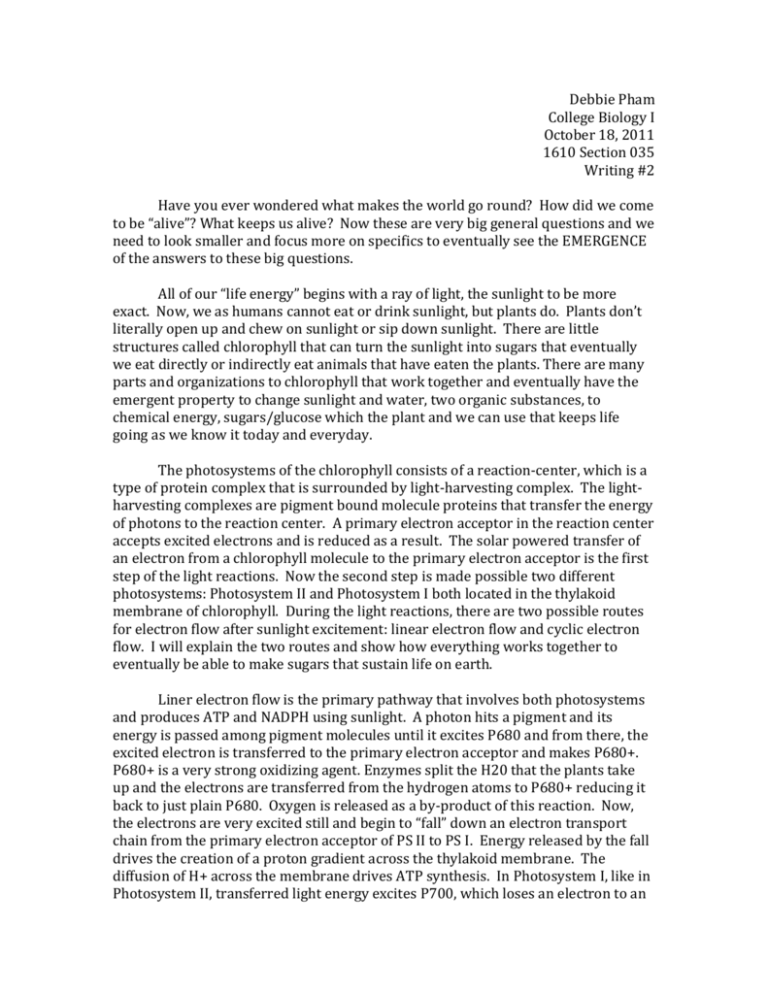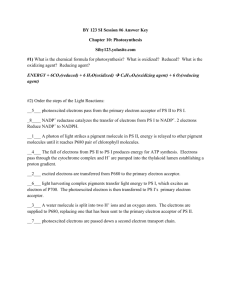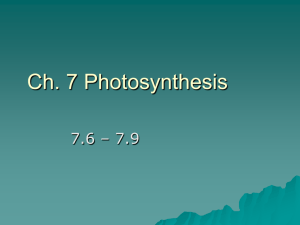File
advertisement

Debbie Pham College Biology I October 18, 2011 1610 Section 035 Writing #2 Have you ever wondered what makes the world go round? How did we come to be “alive”? What keeps us alive? Now these are very big general questions and we need to look smaller and focus more on specifics to eventually see the EMERGENCE of the answers to these big questions. All of our “life energy” begins with a ray of light, the sunlight to be more exact. Now, we as humans cannot eat or drink sunlight, but plants do. Plants don’t literally open up and chew on sunlight or sip down sunlight. There are little structures called chlorophyll that can turn the sunlight into sugars that eventually we eat directly or indirectly eat animals that have eaten the plants. There are many parts and organizations to chlorophyll that work together and eventually have the emergent property to change sunlight and water, two organic substances, to chemical energy, sugars/glucose which the plant and we can use that keeps life going as we know it today and everyday. The photosystems of the chlorophyll consists of a reaction-center, which is a type of protein complex that is surrounded by light-harvesting complex. The lightharvesting complexes are pigment bound molecule proteins that transfer the energy of photons to the reaction center. A primary electron acceptor in the reaction center accepts excited electrons and is reduced as a result. The solar powered transfer of an electron from a chlorophyll molecule to the primary electron acceptor is the first step of the light reactions. Now the second step is made possible two different photosystems: Photosystem II and Photosystem I both located in the thylakoid membrane of chlorophyll. During the light reactions, there are two possible routes for electron flow after sunlight excitement: linear electron flow and cyclic electron flow. I will explain the two routes and show how everything works together to eventually be able to make sugars that sustain life on earth. Liner electron flow is the primary pathway that involves both photosystems and produces ATP and NADPH using sunlight. A photon hits a pigment and its energy is passed among pigment molecules until it excites P680 and from there, the excited electron is transferred to the primary electron acceptor and makes P680+. P680+ is a very strong oxidizing agent. Enzymes split the H20 that the plants take up and the electrons are transferred from the hydrogen atoms to P680+ reducing it back to just plain P680. Oxygen is released as a by-product of this reaction. Now, the electrons are very excited still and begin to “fall” down an electron transport chain from the primary electron acceptor of PS II to PS I. Energy released by the fall drives the creation of a proton gradient across the thylakoid membrane. The diffusion of H+ across the membrane drives ATP synthesis. In Photosystem I, like in Photosystem II, transferred light energy excites P700, which loses an electron to an electron acceptor. P700+ accepts an electron passed down from Photosystem II via the electron transport chain. After arriving at Photosystem I the electrons must be re-excited and when it does, each electron “falls” down another electron transport chain from the primary electron acceptor of PS I to the protein ferredoxin. The electrons are then transferred to NADP+ and reduce it to NADPH. The electrons of the NADPH are available for the reactions of the Calvin cycle and this process also removes an H+ from the stroma. The second option for electron flow is the cyclic flow. It uses only Photosystem I and produces ATP, but not NADPH and no oxygen is released. The cyclic electron flow generates surplus ATP, satisfying the higher demand in the Calvin Cycle. The Calvin Cycle builds sugar from smaller molecules by using ATP and the reducing power of electrons carried by NADPH. Carbon enters the cycle as CO2 and goes through 3 phases: Carbon fixation, Reduction, Regeneration of the CO2 acceptor (RuBP), the eventually leaves as a sugar named glyceraldehyde 3phosphate (G3P). For the synthesis of 1 G3P, the Calvin cycle must take place three times, fixing three molecules of CO2. That G3P is then used to make glucose and or other organic molecules. The glucose is now chemical energy that the plants use for cell functions and eventually we eat either directly or indirectly to sustain our own cell functions as well. The definition of emergent property is any unique property that "emerges" when component objects are joined together in constraining relations to "construct" a higher-level aggregate object, a novel property that unpredictably comes from a combination of two or more simpler constituents. Now, I’ve broken down the constituents and steps that make photosynthesis happen within plants and you now have an individual understanding of what each Photosystem both II and I, each protein in the two election transport chains, each H2O input and O2 released, each electron, and excited photon. All of these systems and components alone could not function alone effectively to give us the result of sugars. The electrons themselves are needed from the H2O input in the light reactions in Photosystem II. Think about the single proteins that make up the electron chain. Without the others there would not be a step to step falling that would best utilize the energy of the falling electron. The Calvin Cycle could not keep transforming the CO2 from the air to usable Glucose if not for the light reactions that created ATP and NADPH that constantly fuel the Calvin cycle. The analogy that I love and has stuck with me is the story of the bicycle. The wheels or even the handlebars alone are almost useless if not for the rest of the bike such as the proteins in photosynthesis. Even if you do have all the parts, they still render useless if not put together in the right order or place such as the Photosystems II and Photosystems I of the chloroplasts. This might be a far stretch, but this has helped realize a new perspective of life. Sometimes we might feel small and insignificant, but even the smallest of things such as chloroplasts belonging in the cell of plants can be the reason why life can be on earth. So if you ever feel small, just remember that in the right “system” along with the right “components” you can make a difference with your own emergent properties.




